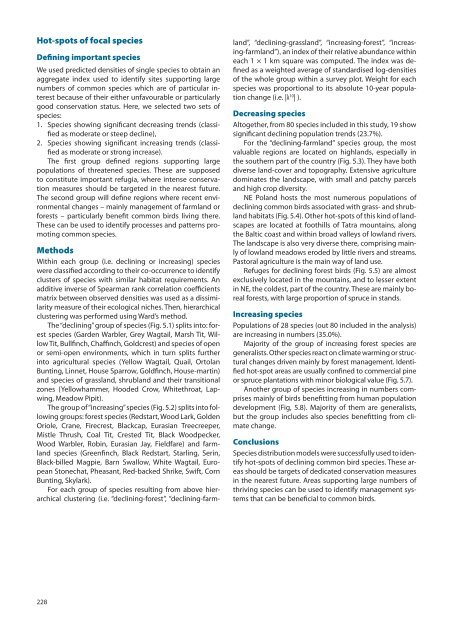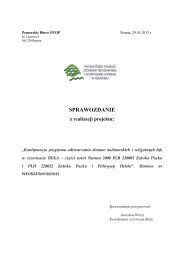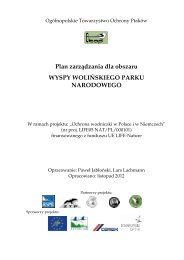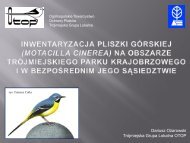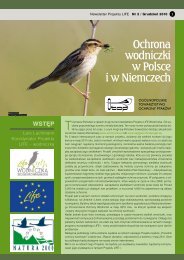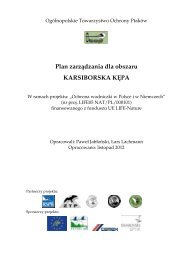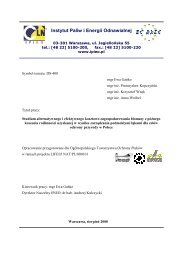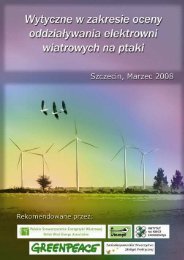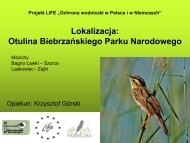Atlas pospolitych ptaków lęgowych Polski
Atlas pospolitych ptaków lÄgowych Polski
Atlas pospolitych ptaków lÄgowych Polski
- No tags were found...
You also want an ePaper? Increase the reach of your titles
YUMPU automatically turns print PDFs into web optimized ePapers that Google loves.
Hot-spots of focal species<br />
Defining important species<br />
We used predicted densities of single species to obtain an<br />
aggregate index used to identify sites supporting large<br />
numbers of common species which are of particular interest<br />
because of their either unfavourable or particularly<br />
good conservation status. Here, we selected two sets of<br />
species:<br />
1. Species showing significant decreasing trends (classified<br />
as moderate or steep decline),<br />
2. Species showing significant increasing trends (classified<br />
as moderate or strong increase).<br />
The first group defined regions supporting large<br />
populations of threatened species. These are supposed<br />
to constitute important refugia, where intense conservation<br />
measures should be targeted in the nearest future.<br />
The second group will define regions where recent environmental<br />
changes – mainly management of farmland or<br />
forests – particularly benefit common birds living there.<br />
These can be used to identify processes and patterns promoting<br />
common species.<br />
Methods<br />
Within each group (i.e. declining or increasing) species<br />
were classified according to their co-occurrence to identify<br />
clusters of species with similar habitat requirements. An<br />
additive inverse of Spearman rank correlation coefficients<br />
matrix between observed densities was used as a dissimilarity<br />
measure of their ecological niches. Then, hierarchical<br />
clustering was performed using Ward’s method.<br />
The “declining” group of species (Fig. 5.1) splits into: forest<br />
species (Garden Warbler, Grey Wagtail, Marsh Tit, Willow<br />
Tit, Bullfinch, Chaffinch, Goldcrest) and species of open<br />
or semi-open environments, which in turn splits further<br />
into agricultural species (Yellow Wagtail, Quail, Ortolan<br />
Bunting, Linnet, House Sparrow, Goldfinch, House-martin)<br />
and species of grassland, shrubland and their transitional<br />
zones (Yellowhammer, Hooded Crow, Whitethroat, Lapwing,<br />
Meadow Pipit).<br />
The group of “increasing” species (Fig. 5.2) splits into following<br />
groups: forest species (Redstart, Wood Lark, Golden<br />
Oriole, Crane, Firecrest, Blackcap, Eurasian Treecreeper,<br />
Mistle Thrush, Coal Tit, Crested Tit, Black Woodpecker,<br />
Wood Warbler, Robin, Eurasian Jay, Fieldfare) and farmland<br />
species (Greenfinch, Black Redstart, Starling, Serin,<br />
Black-billed Magpie, Barn Swallow, White Wagtail, European<br />
Stonechat, Pheasant, Red-backed Shrike, Swift, Corn<br />
Bunting, Skylark).<br />
For each group of species resulting from above hierarchical<br />
clustering (i.e. “declining-forest”, “declining-farmland”,<br />
“declining-grassland”, “increasing-forest”, “increasing-farmland”),<br />
an index of their relative abundance within<br />
each 1 × 1 km square was computed. The index was defined<br />
as a weighted average of standardised log-densities<br />
of the whole group within a survey plot. Weight for each<br />
species was proportional to its absolute 10-year population<br />
change (i.e. |λ 10 | ).<br />
Decreasing species<br />
Altogether, from 80 species included in this study, 19 show<br />
significant declining population trends (23.7%).<br />
For the “declining-farmland” species group, the most<br />
valuable regions are located on highlands, especially in<br />
the southern part of the country (Fig. 5.3). They have both<br />
diverse land-cover and topography. Extensive agriculture<br />
dominates the landscape, with small and patchy parcels<br />
and high crop diversity.<br />
NE Poland hosts the most numerous populations of<br />
declining common birds associated with grass- and shrubland<br />
habitats (Fig. 5.4). Other hot-spots of this kind of landscapes<br />
are located at foothills of Tatra mountains, along<br />
the Baltic coast and within broad valleys of lowland rivers.<br />
The landscape is also very diverse there, comprising mainly<br />
of lowland meadows eroded by little rivers and streams.<br />
Pastoral agriculture is the main way of land use.<br />
Refuges for declining forest birds (Fig. 5.5) are almost<br />
exclusively located in the mountains, and to lesser extent<br />
in NE, the coldest, part of the country. These are mainly boreal<br />
forests, with large proportion of spruce in stands.<br />
Increasing species<br />
Populations of 28 species (out 80 included in the analysis)<br />
are increasing in numbers (35.0%).<br />
Majority of the group of increasing forest species are<br />
generalists. Other species react on climate warming or structural<br />
changes driven mainly by forest management. Identified<br />
hot-spot areas are usually confined to commercial pine<br />
or spruce plantations with minor biological value (Fig. 5.7).<br />
Another group of species increasing in numbers comprises<br />
mainly of birds benefitting from human population<br />
development (Fig, 5.8). Majority of them are generalists,<br />
but the group includes also species benefitting from climate<br />
change.<br />
Conclusions<br />
Species distribution models were successfully used to identify<br />
hot-spots of declining common bird species. These areas<br />
should be targets of dedicated conservation measures<br />
in the nearest future. Areas supporting large numbers of<br />
thriving species can be used to identify management systems<br />
that can be beneficial to common birds.<br />
228


